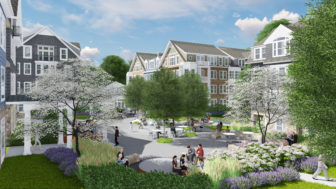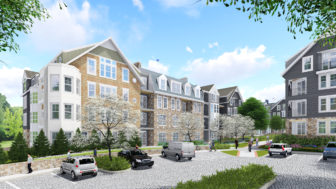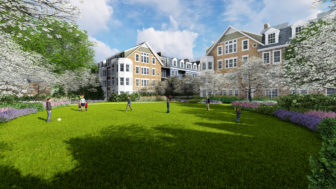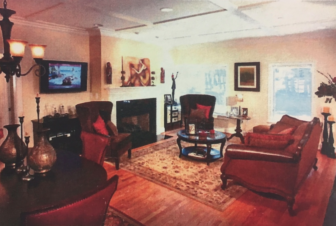Questions about the viability of a new parking system, guarantees regarding the set-aside of some below-market units and the potential that a condo-and-apartment complex could loom conspicuously over parts of Park Street rank high among outstanding concerns regarding the proposed development at Merritt Apartments, the chairman of the New Canaan Planning & Zoning Commission said Tuesday night.

Courtyard view of the proposed new condominium/townhouse and apartment units at Merritt Apartments in New Canaan. Rendering courtesy of S/L/A/M Collaborative
Most of all, perhaps, the Merritt Village as proposed—a plan that would see 123 units built on a combined 3.29-acre parcel at the edge of downtown New Canaan where 38 now exist—raises questions about “the density of the whole project,” P&Z Chairman John Goodwin said during a public hearing.
“One component is—is four stories the right answer or should it be three?—which effectively becomes three-and-a-half [stories] with a roof,” Goodwin said during the hearing, which drew a standing-room only crowd at Town Hall.

Maple Street view of the proposed new condominium/townhouse and apartment units at Merritt Apartments in New Canaan. Rendering courtesy of S/L/A/M Collaborative
“And as the planner has noted, there is the issue of how many units. The planner has shared with the commission his analysis that if we were to apply the current most dense project in New Canaan to [the Merritt Village] project, the number that would fall out would be 95 units, so that is a challenge. And as the planner has pointed out, these issues will reverberate, meaning that if you reduce the number of stories, you reduce the number of units, you potentially reduce the traffic impact, potentially reduce the impact of kids going to schools—there are a whole bunch of reverberations that go on in a positive direction as you bring down the overall scale.”
Voiced during the third hearing on the Merritt Village proposal, the comments mark the first time that P&Z commissioners have spoken publicly about plans filed in June on behalf of property owner M2 Partners Inc., which includes New Canaan resident Arnold Karp.

South lawn view of the proposed new condominium/townhouse and apartment units at Merritt Apartments in New Canaan. Rendering courtesy of S/L/A/M Collaborative
Asked by commissioner Tony Shizari why Merritt Village couldn’t be fewer than 120-plus units, Karp said the figure is driven by the market, costs associated with creating the housing and preserving desirable features—such as preserving some half of the parcel as open space.
“There is a cost to build, there is a cost to develop,” Karp said.
“There are eight units that are going to go to workforce housing. This is not math that is only in New Canaan. If you look at any complex in Fairifeld County, nobody can make their numbers work at two stories. It’s simple: If you want no density, you have throw out all the other things that everybody else wants. As I said to the seniors, short of the town giving them a piece of land, how else do they think the numbers are going to work? It’s an easy equation. Nobody has built this type of development in most towns, because unless the land is given to a builder, they can’t make the numbers work.”

A rendering of a proposed common outdoor area at Merritt Village in New Canaan
He added: “My issue is a 3.5-acre parcel in the Apartment Zone that essentially closes the door in that zone, due to the town’s bad planning, for not putting things in. I can’t be responsible for all the other zoning in town—that is actually up to you guys. We put together I think, a very well organized, very well thought-out project.”
Plans call for 60 condominium and 63 apartment units in four separate, four-story buildings. Merritt Village will include 205 parking spaces, with out 80 percent of those located underground in a pair of garages that leverage what’s known as “tandem parking” (more on that below).
According to a summary from Fairfield-based Kerin and Fazio Valuation Group, Merritt Village will have 26 one-bedroom units, 89 two-bedroom units and eight three-bedroom units, with an open floor plan.

A rendering of the interior at a proposed Merritt Village apartment and condo complex in New Canaan.
The one-bedroom units would rent for about $3,000 to $3,300 per month, two bedrooms $3,600 to $3,900 and three bedrooms $4,500 to $4,800, while the condos would sell for $1 million to $1.2 million. (The application for Merritt Village and attendant studies, including those commissioned by the town on M2’s dime, can be found here—select ‘Merritt Village’ in the dropdown.)
Designed by Glastonbury-based S/L/A/M Collaborative, the project features a pedestrian walkway through the property that will connect Mead Street to Maple Street “with beautiful landscaping and open space areas,” according to the application.
During the 4-hour-plus hearing, several residents took to the podium to speak either in favor or against the proposal.
Those in favor cited demographic data that has found New Canaan seniors need more housing options in and around town, noted that third-party studies including those done at P&Z’s behest have concluded that Merritt Village will have no significant impact on home values or traffic,
New Canaan resident Kevin Moynihan (who, separately, serves on the Town Council—an elected municipal body that has nothing to do with Merritt Village) called Karp a “benign and sensible developer” that New Canaan is fortunate to have. Citing several instances where Karp has volunteered his time, efforts and resources for the greater good—here’s one recent example—Moynihan called him an “enormously generous” person who “has the town’s best interests at heart.”
“I truly believe that Arnold will do everything possible to make the redevelopment of the Merritt Apartments property a complex that that New Canaanites will be very pleased with when completed and a true asset for New Canaan’s future,” he said.
George McEvoy said that some of the opposition to the project, in trying to guess or gauge the developer’s motivations, appears to have taken a strangely personal shape. He called Karp a “genuinely decent” professional with whom he has worked in the past, and a developer who keeps his word and never puts up a structure and then seeks after-the-fact approval for his work (something that’s plagues local land use bodies—here’s one example, here’s another).
“I would be remiss if I didn’t make a comment about the character assassination and demonization of Arnold Karp and his business since this started,” McEvoy said. “Everybody talks about, ‘Well we don’t do that type of thing in New Canaan.’ Well, there’s been a lot of that we-don’t-do-that-kind-of-thing going on with this project and I think it’s totally inappropriate.”
Not all objections fell into that category.
At the hearing, some of those opposed called for more landscaping with taller trees to “soften” the visual impact of the proposed buildings, questioned the future of a burial ground located on the property, wondered just how it was possible to say for sure what demographics of people would move into the new units, raised fears about new young families moving in and crowding public schools as a result, and questioned consultants’ findings regarding how Merritt Village would affect traffic, real estate values and the more nuanced feel or sensibility of New Canaan.
Since the first public hearing on the proposal, in June, P&Z has called for independent studies regarding such matters as well as peer reviews (all paid for by Karp) of the work done by consultants whose findings form large parts of the Merritt Village application.
Kerin Fazio, the firm which completed a “real estate impact analysis,” found that “the proposed 123-unit multifamily development will have no negative impact on the market value of neighboring properties and will not change the character of the subject’s neighborhood.” “Additionally, the proposed development will have no negative impact on the existing single-family housing market in town,” the consultants found.
At Tuesday’s hearing, David Herbst of Kerin Fazio reported on how Merritt Village would impact New Canaan’s condo market. Saying the limited number of new construction condos in New Canaan prompted him to look to surrounding communities, Herbst reported that “the majority of currently available new condominium units ware within townhouse-style developments [at 79 percent].”
“Demand for flat-style apartments is primarily derived from senior residents seeking low maintenance and accessible living options. In the case of the subject [Merritt Village proposal], it is expected that demand will be derived primarily from residents looking to downsize from a single family dwelling. Due to the limited supply of similar units, the subject will be marketable to New Canaan residents and the wider lower Fairfield County market.”
At least one P&Z commissioner seemed nonplussed by Kerin’s overall findings regarding the housing market. Shizari said he was “surprised that your conclusion was that it would have no impact because, like you said, it would have to mean these 120-odd units are occupied by either out-of-towners coming in or occupied by people otherwise leaving town.”
“Because if it is anything other than that, it would impact property values,” Shizari said. “Supply and demand says if you are introducing new units, it would impact it. So I am surprised that you are saying it’s zero.”
In at least two ways, opponents of the Merritt Village proposal voiced fears and objections that, according to P&Z commissioners and some from the public who addressed them, have little basis in fact.
For example, some seemed to say that amending New Canaan’s Zoning Regulations in order to make Merritt Village possible would open up the town to similar developments in other areas.
Yet, as the attorney for M2 Partners—Steve Finn of Stamford-based Wofsey Rosen Kweskin & Kuriansky LLP—underscored at the hearing, the proposed “overlay” to the Apartment Zone, where Merritt Apartments currently sits, is so specific to the parcel in question that it could not possibly apply to other parts of town.
Also, some opponents invoked the specter of a state law concerning affordable housing in a way that appeared to guess at Karp’s intentions. Under the Affordable Housing Appeals Act, towns (such as New Canaan) that do not meet a rigorous state standard with respect to the portion of total housing stock that is “affordable” are subject to a loophole whereby developers can skirt local planning decisions.
Some at the hearing went so far as to use the word ‘blackmail’ in describing the Merritt Village proposal.
Yet according to New Canaan resident Art Casavant, a banker who said he has worked as a manager of tax credits investing in many thousands of units of low-income housing, P&Z ought not to base its Merritt Village decision on the affordable housing argument, but “on the merits of everything but that.” Casavant said that “affordable housing” is a closely defined term that specifies details such as numbers of units, square feet in the units and rental rates. Developers who wish to pursue affordable housing projects when they’re turned down by local planning officials face “a whole set of restrictions” and one important consideration under the state statute is whether a town has a plan in place to work toward the requirements of the Affordable Housing Appeals Act (which New Canaan does, with the rebuilding project at Mill Pond).
Commissioner Laszlo Papp went further, saying that as a result of certain news reports, there has been “very confusing and needless” discussion regarding the Affordable Housing Appeals Act, often referred to by its statute number, “8-30g.”
“I do not think this is a realistic solution or option at all,” Papp said.
“I remind you that the state law not only removes the development of the physical aspect from the town jurisdiction, but also the occupancy, as well. The town will not be able to decide who will occupy the potential affordable units. If that would be considered at all, it is quite obvious that it would be an even larger project and that would bring in something like between 30 to 50 affordable units for people who, probably none of them probably will be New Canaan, they would be all from out of town and it would provide a mix which would gravely compromise the economic viability and the marketability of the other units as well. So I don’t believe that anybody would be willing or would be reasonably going that route.”
Ultimately, the commission continued the hearing to a yet-to-be-scheduled future special meeting—likely sometime in mid- to late-September, Goodwin said—and agreed to deliver to the applicant this week a list of additional questions and outstanding items.
Some of those address traffic concerns.
According to Wallingford-based consulting engineer John P. Thompson’s peer review of a traffic study that Finn had included in the original application for Merritt Village, there will be “no probable impact on the resultant levels-of-service” on neighborhood streets following the development. Even so, regarding a proposed access drive off of Park Street, Thompson said “a plan which graphically depicts how this new site drive would be constructed along with the required ISDs would be helpful in confirming the applicant’s representations.”
Thompson also flagged proposed “tandem parking” in underground garages planned for Merritt Village—under the space-saving system, which is relatively new, two cars (in reality they would be owned by those occupying a single housing unit) park one in front of the other, so that one vehicle may be effectively “blocked in” at times, as per the owners’ schedules and needs.
He also called for details on how the applicant would ensure that the adjacent St. Aloysius parking area is not improperly used, and for the number of dump trucks entering and exiting the site during excavation. Thompson further called for an explanation as to why non-peak hour site generated traffic volumes “do not adversely impact any of the five intersections that were analyzed as part of this application” and asked for a breakdown of the pros and cons of a possible “new” vehicular site drive on Mead Street, as well as the “option of physically connecting the two [underground] garages and then controlling access and egress by gates or some type of card control.”
Attorney Joseph J. Rucci Jr. of the Darien-based Rucci Law Group raised specific concerns on behalf of St. Aloysius, saying a major open question revolved around what impact the development could have on Maple Street and the larger area of the parish. Noting that no blasting could be done in such proximity to the church’s buildings, Rucci underscored the importance of access to Stapleton Hall and raised concerns about the effect that increased traffic could have on St. Aloysius’s on- and off-street parking.
“Our concern is focused on our ability to continue to run our parish and our mission,” he said.
Finn—who at one point in the hearing noted that M2 Partners during pre-application talks had started at 150 to 160 units, and already had compromised down to 123—said that nothing in St. A’s list of conditions struck him immediately as undoable.
More than one commissioner in raising questions about the application noted that New Canaan is a singular town with a unique sensibility.
To that Papp responded that “this is a unique site in a unique town, and it has to be treated as a unique site.”
“And obviously it will be developed, it has to be developed and it is suitable to the higher density.”
Papp conceded that “the intensity of this proposal appears to be unacceptable to a fairly large part of the town, and that has to be looked at in a critical way, and may require some questioning.”
In the end, he said, “a reasonable compromise has to be worked out between the commission and the developer, and the result may be that nobody will be totally happy—neither the developer will go home happy, nor the neighbors who spoke here will go [home] entirely happy—but I think the town will be well served if such a compromise is the result of further discussions.”
I watched some of the P+Z meeting on Channel 79 and I heard the 123 units referred to as “senior housing” and “affordable housing”. The 123 units being built are neither. These will be in-town single level units that will be marketed to anyone who will pay for them.
$1,000 per square foot for a condo is not below market given the per square foot rates on current townhouses and condos in the area.
I checked Realtor.com this morning to look at in-town condos/town houses currently for sale. Here are the results:
– luxury Townhouse on Summer Street $420 psf
– Park Street $537 psf and $464 psf
– Richmond Hill condo $476 psf
– Main Street – $524 psf
– Forest Street – $288 psf
– Pride’s Crossing – $507 & $668psf
– Ardsley Square (Maple Street) – $510 psf
Agreed. If I live in Manhattan and want to move to the suburbs with my young family this is EXACTLY the type of place that is perfect and still “cheap” by local standards (vs. Rye, Larchmont, Greenwich, Darien, Westport, etc). Also, the young people currently living in Harbor Point, Stamford that want to keep condo amenities while realizing they need a good school district for their young children will think the same thing. So the no effect on the schools argument is a complete joke. It happened in Darien with the Kensett. Overall I still like the project and support making downtown more conducive to the modern “urban” living movement, but I think to downplay the effect on the school district is doing a disservice to the town.
Seth, am big fan of wanting to see New Canaan center move with the times and adopt more modern urban planning (I’ve commented on Library expansion along same lines), while keeping village charms – – which is achievable a la many desirable northern European town developments (a lot allowance for pedestrians, cyclists, web-enabled town center as home-away-from-home). I support the ‘new’ housing as it does in fact allow two key residents to join and remain: young families, and senior citizens. Both essential to the wellbeing of NC center. What seems to be missing in NC is a comprehensive down-town development plan – – seems it is more about individual projects than a recognition that a urban plan must be all-inclusive (e.g parking for shopping/employees, parking for commuter needs, The Hub, Merritt, Playhouse, Saxe, Library, the Y, and so on). I think more people in a well-planned NC Central area, can be a very unique and desirable place to be. NC’s current make-up is regional unique in having such potential, and it’d be great to see us make the most of it.
Well, a few years ago, First Selectmen Jeb Walker tried to do just that by establishing the Long-Range Planning Committee. In my opinion, they were not only doing important work but thinking creatively, so that the town would not just look at our spaces as they are, but as they could be, including reconfiguring where things are held, and perhaps even establishing a sorely-need public green (which the Pop-up Park tries to be I think). But, it was met with a lot of criticism and was shut down. It was too bad, I think, and maybe too late, because the Town Hall is done, the Library has its space, the Y is already going forward, etc. The Plan of Conservation and Development doesn’t really reimagine the town; it looks to preserve its character, but not in the visionary way you are bringing up.
I would urge the members of Planning & Zoning to write in restrictions on whatever variance they eventually grant, to hold the developer to the many representations that have been made, that this will be housing for Seniors who wish to remain in New Canaan. There is no reason that age & occupancy restrictions cannot be imposed. This development will obviously appeal to first time buyers with children who cannot afford a home in walking distance to town.
This is perfect entry level housing for young families with children. It would create a huge influx of new students for the schools requiring expansion of the schools to accommodate them, additional faculty, and common spaces. This housing, as rentals, and below median cost homes, will have lower than median taxes, and the rest of the town will pick up the bill. These are unintended consequences of this development. I don’t know why anyone in New Canaan would want to approve this project, and absorb higher taxes in perpetuity to support it.
This development can’t happen. Why are we supporting padding the pockets of a developer. The town’s facilities can’t support without investment this expansion, the South School is already beyond capacity. That will mean redistricting for the elementary school so West School will get more families from Town and East’s District will move in toward Millport Ave. The developer’s “Consultant” idea that traffic will not increase when 3x the units are added, or 100 more families, is unbelievable. Take a look at Richmond hill’s chock-a-block development and the Roger Sherman Inn’s units, and its easy to see a glut coming.
While i am a huge proponent of maintaining and adding to open space, i do wonder if this aspect of it should be reconsidered for these apartments. Would reducing that allow the building height to be reduced? Or would it increase the sense of overcrowding? I’d also like to know whether having so much open space is primarily a commercial decision rather than an aesthetic consideration, i.e., having common outdoor areas as a marketing tool for prospective buyers.
In addition to declining home sales, I think this recent article from the Atlantic Monthly pretty much debunks the myth that any kind of additional housing is “needed” in New Canaan:
http://www.theatlantic.com/business/archive/2016/08/decline-suburbs/496445/
The only people constantly talking about New Canaan needing any more housing are local builders.
Actually I think this article perfectly supports the need for this type of housing. In-town living in a dynamic community such as NC is more popular than ever with millennials, young families, etc. It’s the 1+acre 4 bedroom, 3 bath colonial suburban lifestyle that is hurting, this article illustrates that.
The Time Article on Education Funding, if enacted will hurt NC. For families who pay a premium for being in NC for the schools, and most do, a decline in funding of the schools by these proposed laws will drive down demand. Please read this article
http://www.nytimes.com/2016/09/08/nyregion/connecticut-public-schools-inequality-judge-orders.html